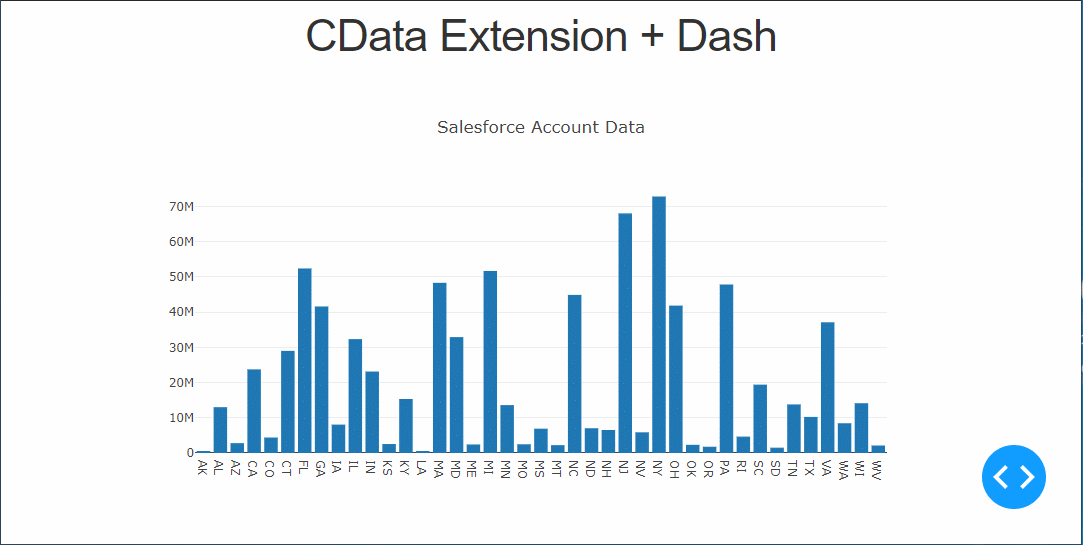Model Context Protocol (MCP) finally gives AI models a way to access the business data needed to make them really useful at work. CData MCP Servers have the depth and performance to make sure AI has access to all of the answers.
Try them now for free →Use Dash to Build to Web Apps on Sage 50 UK Data
Create Python applications that use pandas and Dash to build Sage 50 UK-connected web apps.
The rich ecosystem of Python modules lets you get to work quickly and integrate your systems more effectively. With the CData Python Connector for Sage 50 UK, the pandas module, and the Dash framework, you can build Sage 50 UK-connected web applications for Sage 50 UK data. This article shows how to connect to Sage 50 UK with the CData Connector and use pandas and Dash to build a simple web app for visualizing Sage 50 UK data.
With built-in, optimized data processing, the CData Python Connector offers unmatched performance for interacting with live Sage 50 UK data in Python. When you issue complex SQL queries from Sage 50 UK, the driver pushes supported SQL operations, like filters and aggregations, directly to Sage 50 UK and utilizes the embedded SQL engine to process unsupported operations client-side (often SQL functions and JOIN operations).
Connecting to Sage 50 UK Data
Connecting to Sage 50 UK data looks just like connecting to any relational data source. Create a connection string using the required connection properties. For this article, you will pass the connection string as a parameter to the create_engine function.
Note: Only Sage 50 UK 2012 and above are supported.
The User and Password properties, under the Connection section, must be set to valid Sage 50 UK user credentials. These values will be the same used to log in to the Sage 50 UK software.
Additionally, the URL property, under the Connection section, will need to be set to the address of the company dataset desired. To obtain the address, do the following:
- If you have not already done so, open the Sage 50 UK software.
- Click Tools -> Internet Options.
- Select the SData Settings tab.
- Click the Details button next to Sage 50 Accounts. A window is displayed containing a list of company names along with the address to their corresponding datasets.
- Set the URL property to the value in the address field next to the company desired.
After installing the CData Sage 50 UK Connector, follow the procedure below to install the other required modules and start accessing Sage 50 UK through Python objects.
Install Required Modules
Use the pip utility to install the required modules and frameworks:
pip install pandas pip install dash pip install dash-daq
Visualize Sage 50 UK Data in Python
Once the required modules and frameworks are installed, we are ready to build our web app. Code snippets follow, but the full source code is available at the end of the article.
First, be sure to import the modules (including the CData Connector) with the following:
import os import dash import dash_core_components as dcc import dash_html_components as html import pandas as pd import cdata.sage50uk as mod import plotly.graph_objs as go
You can now connect with a connection string. Use the connect function for the CData Sage 50 UK Connector to create a connection for working with Sage 50 UK data.
cnxn = mod.connect("URL=http://your-server:5493/sdata/accounts50/GCRM/your-address;User=Manager;")
Execute SQL to Sage 50 UK
Use the read_sql function from pandas to execute any SQL statement and store the result set in a DataFrame.
df = pd.read_sql("SELECT Name, FinanceBalance FROM TradingAccounts WHERE TradingAccountUUID = 'c2ef66a5-a545-413b-9312-79a53caadbc4'", cnxn)
Configure the Web App
With the query results stored in a DataFrame, we can begin configuring the web app, assigning a name, stylesheet, and title.
app_name = 'dash-sage50ukedataplot' external_stylesheets = ['https://codepen.io/chriddyp/pen/bWLwgP.css'] app = dash.Dash(__name__, external_stylesheets=external_stylesheets) app.title = 'CData + Dash'
Configure the Layout
The next step is to create a bar graph based on our Sage 50 UK data and configure the app layout.
trace = go.Bar(x=df.Name, y=df.FinanceBalance, name='Name')
app.layout = html.Div(children=[html.H1("CData Extension + Dash", style={'textAlign': 'center'}),
dcc.Graph(
id='example-graph',
figure={
'data': [trace],
'layout':
go.Layout(title='Sage 50 UK TradingAccounts Data', barmode='stack')
})
], className="container")
Set the App to Run
With the connection, app, and layout configured, we are ready to run the app. The last lines of Python code follow.
if __name__ == '__main__':
app.run_server(debug=True)
Now, use Python to run the web app and a browser to view the Sage 50 UK data.
python sage50uk-dash.py

Free Trial & More Information
Download a free, 30-day trial of the CData Python Connector for Sage 50 UK to start building Python apps with connectivity to Sage 50 UK data. Reach out to our Support Team if you have any questions.
Full Source Code
import os
import dash
import dash_core_components as dcc
import dash_html_components as html
import pandas as pd
import cdata.sage50uk as mod
import plotly.graph_objs as go
cnxn = mod.connect("URL=http://your-server:5493/sdata/accounts50/GCRM/your-address;User=Manager;")
df = pd.read_sql("SELECT Name, FinanceBalance FROM TradingAccounts WHERE TradingAccountUUID = 'c2ef66a5-a545-413b-9312-79a53caadbc4'", cnxn)
app_name = 'dash-sage50ukdataplot'
external_stylesheets = ['https://codepen.io/chriddyp/pen/bWLwgP.css']
app = dash.Dash(__name__, external_stylesheets=external_stylesheets)
app.title = 'CData + Dash'
trace = go.Bar(x=df.Name, y=df.FinanceBalance, name='Name')
app.layout = html.Div(children=[html.H1("CData Extension + Dash", style={'textAlign': 'center'}),
dcc.Graph(
id='example-graph',
figure={
'data': [trace],
'layout':
go.Layout(title='Sage 50 UK TradingAccounts Data', barmode='stack')
})
], className="container")
if __name__ == '__main__':
app.run_server(debug=True)

